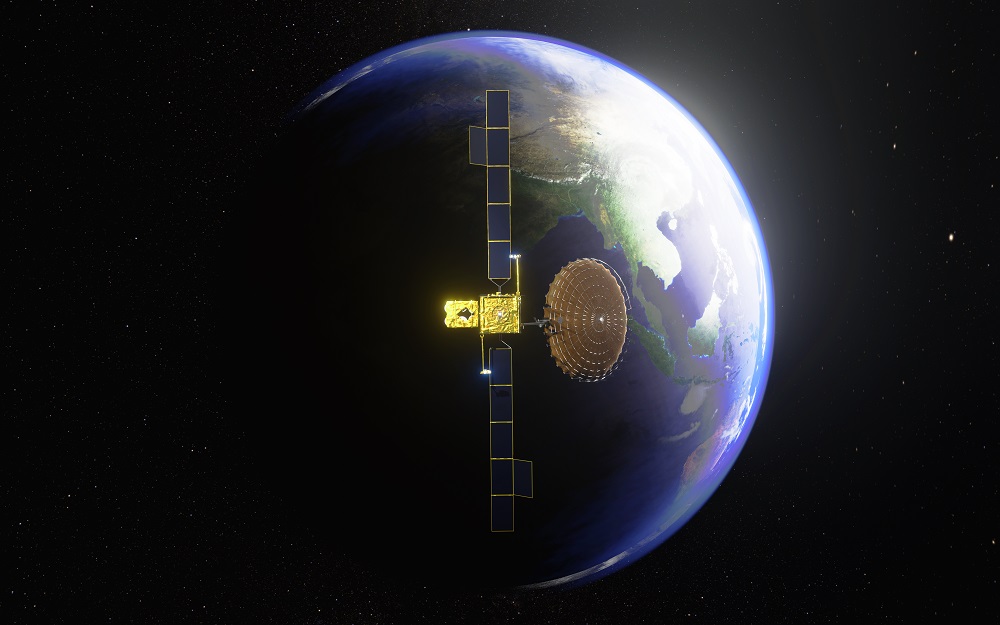WASHINGTON — A new Inmarsat communications satellite has suffered an “unexpected anomaly,” the second in as many months for a Viasat-owned spacecraft that could create bigger headaches for the space insurance sector.
Viasat, which completed its acquisition of Inmarsat in May, announced Aug. 24 that the Inmarsat-6 (I-6) F2 spacecraft encountered a problem with its power subsystem while raising its orbit after its February launch. The company didn’t elaborate on the nature of the problem or when it took place, but noted the similar I-6 F1 satellite, launched in late 2021, is working normally.
“At this stage, Viasat and Airbus, the satellite’s manufacturer, are working to determine the root cause of the anomaly and assess whether the satellite will be able to perform its mission,” Viasat said in a statement. It added that Airbus Defence and Space considered this an “unprecedented event” as no previous Airbus-built spacecraft had suffered an in-orbit failure.
A SpaceX Falcon 9 launched I-6 F2 in February, placing it into a geostationary transfer orbit. The spacecraft was designed to use its electric propulsion system to go to its final geostationary orbit over the Atlantic. According to the U.S. Space Force’s Space-Track service, I-6 F2 was in an orbit of 23,061 by 48,126 kilometers with an inclination of 3.28 degrees, still well short of geostationary orbit. There has been no significant changes in its orbital parameters since mid-August.
Viasat downplayed the significance of I-6 F2, noting that the satellite had yet to enter service so its loss would not disrupt any customers. “I-6 F2’s initial mission was essentially to provide spare L-band and four gigabits per second of additional Ka-band capacity, consistent with deploying and operating a resilient, redundant network,” Mark Dankberg, chief executive of Viasat, said in a statement.
The announcement comes six weeks after Viasat acknowledged a problem deploying the main antenna on its ViaSat-3 Americas satellite, launched April 30. That antenna, previously described by the company as “exceptionally large” in order to provide consumer broadband services, was provided by a third-party supplier for the Boeing-built satellite.
In an Aug. 9 earnings call, Dankberg said Viasat was not ready yet to declare ViaSat-3 Americas a total loss. The company was still determining how much performance it could get from the broadband payload, which was designed to provide 1 terabit per second of capacity. He said the company expected to determine a plan forward by its next earnings call in November. That could include building a replacement satellite or using one of two other ViaSat-3 satellites, yet to be launched, to replace ViaSat-3 Americas.
If the company does declare ViaSat-3 Americas a total loss, that and I-6 F2 could deal a double whammy to the space insurance field. Insurers were already preparing for a claim of as large as $420 million from ViaSat-3 Americas. At the time, one insurer warned that the ViaSat-3 Americas claim could drive insurers from the market, reducing capacity and raising premiums for other companies.
In an Aug. 25 research note, Louie DiPalma, analyst with investment firm William Blair, said Viasat had a $350 million policy on I-6 F2. Those claims, along with the redundancy from Viasat’s overall satellite fleet, would mitigate the near-term financial effect of the two satellite losses on Viasat.
However, he added, “over the long term, Viasat and other industry participants will likely experience significant challenges with obtaining insurance for future satellite launches.”
Shares of Viasat were down about 5% in trading Aug. 25 on the Nasdaq. The company is near its 52-week low, down nearly 50% from a high in early June.
